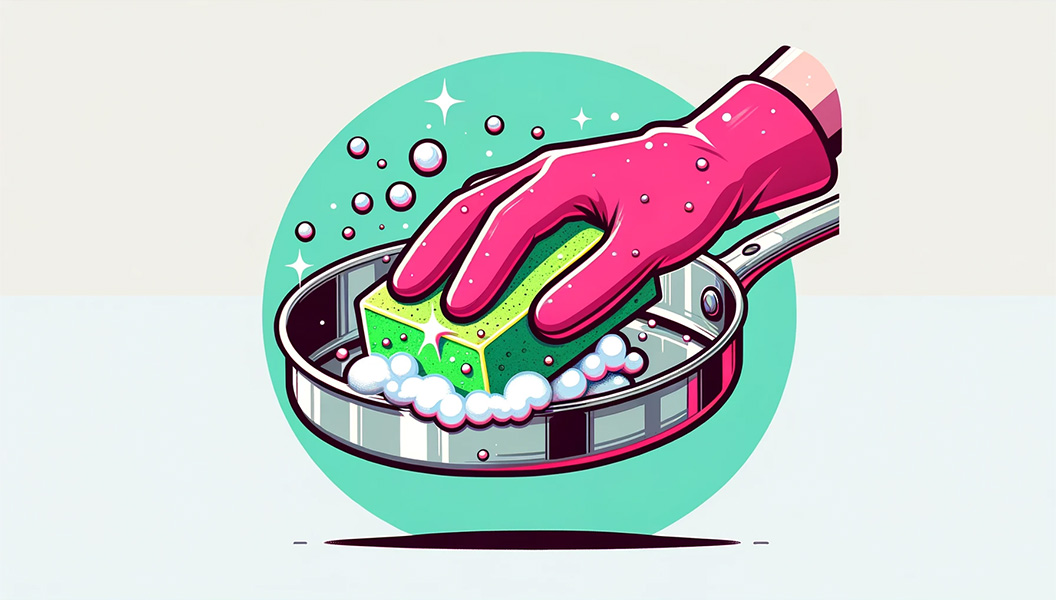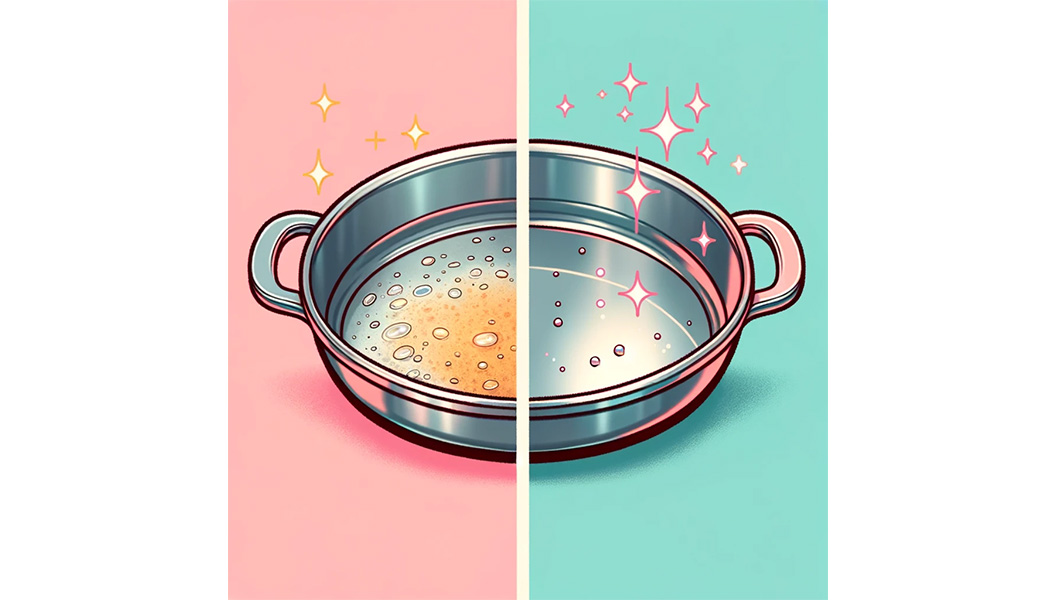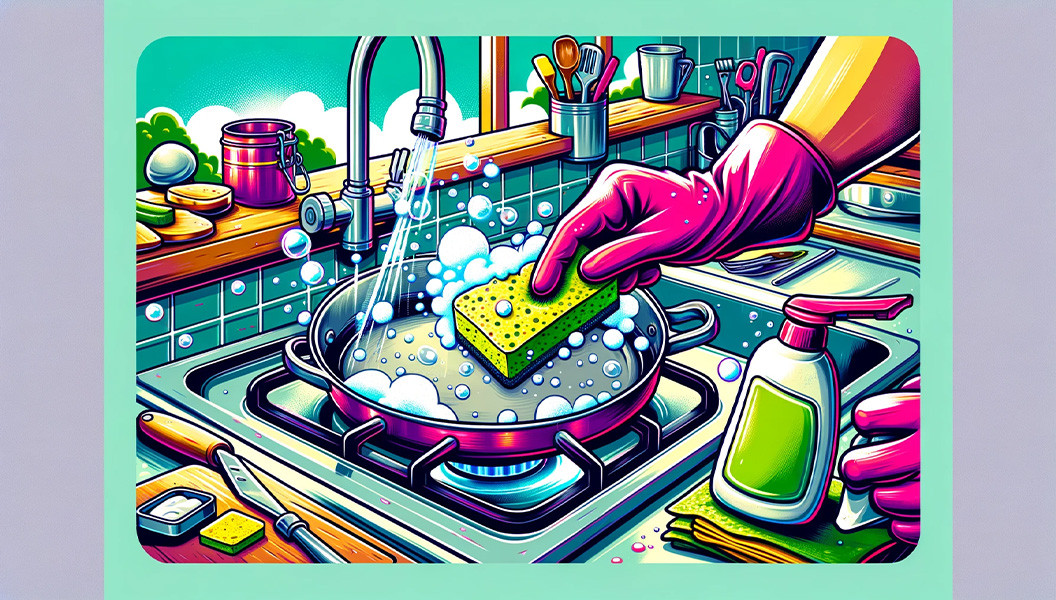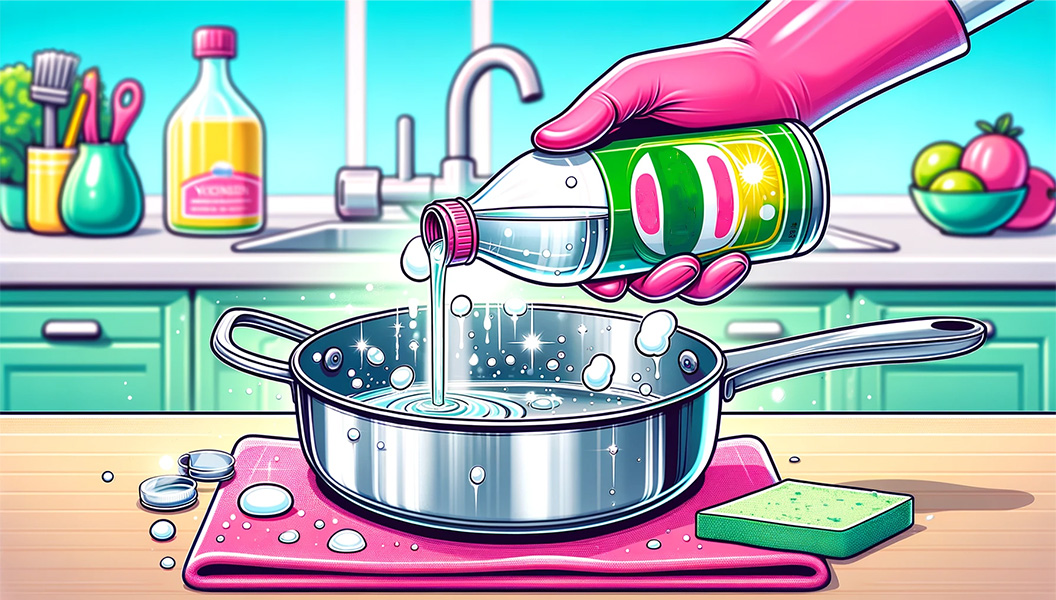Stainless steel pans are prized possessions in every kitchen, cherished for their durability, even heat distribution, and timeless elegance. Whether you're a seasoned culinary enthusiast or a home cook just starting your culinary journey, these gleaming kitchen essentials can turn ordinary meals into extraordinary culinary creations. Nevertheless, maintaining these pans' luster and optimal cooking performance over time requires proper care and cleaning.
Below, we'll tell you how to clean stainless steel pans. From cleaning stainless steel pans stuck on cleaning burnt stainless steel pan, we'll equip you with practical tips and tricks to elevate your stainless steel pan's longevity.
How To Clean Stainless Steel Pans After Each Use

For everyday messes from cooking, you'll need warm, soapy water and a non-abrasive sponge!
Step 1: Let the stainless steel pans cool. Throwing a hot pan under cold water will produce a thermal shock, resulting in a warped pan. Even hot tap water will not match the temperature of a just-used pan! Let your pan cool down before starting to clean it.
Step 2: You only need hot water, standard dish soap, and some elbow grease to get the job done! A quick scrub will handle excess oil or bits of food particles left over from your cooking.
Step 3: After scrubbing the stainless steel pan clean, rinse it in cold water and dry it with a clean towel.
How To Remove Discoloration On Stainless Steel Pans

Step 1: Start by washing your stainless pan with a mixture of vinegar and water. Mix equal parts of white vinegar and water in the pan and gently heat it on the stove. The acidic nature of vinegar helps to loosen and lift discoloration caused by heat and food residue. After simmering for a few minutes, allow the pan to cool, then wash it with warm soapy water.
Step 2: If discoloration persists, use baking soda, a natural, non-abrasive cleaner. Make a paste with baking soda and a small amount of warm water and apply it to the discolored areas of the stainless steel pan. Use a soft sponge or cloth to scrub the surface gently in a circular motion. The mild abrasive properties of baking soda will help remove the discoloration without scratching the stainless steel.
Step 3: After scrubbing, rinse the pan thoroughly with water to remove any baking soda or vinegar residue. If discoloration remains, repeat the process, focusing on the stubborn areas.
Step 4: Once the discoloration is removed, dry the stainless steel pan completely with a clean towel to prevent water spots. For extra shine, you can polish the stainless steel cookware with a few drops of olive oil or a stainless steel cleaner, rubbing it in with a soft cloth.
How To Clean Stainless Steel Pans With Stuck On Food

Step 1: Begin your pan rescue mission by filling the stainless steel pan with hot water and completely submerging the burnt-on food. Add a few drops of your favorite dish soap to the water for its grease-cutting abilities. This initial soak is crucial—it loosens the grip of the burnt food, making it more pliable and easier to remove.
For best results, let the stainless steel pans soak for at least an hour, but if the food is particularly stubborn, consider leaving it overnight. This extended soaking time allows the soapy water to penetrate and soften the burnt residue.
Step 2: After soaking, the burnt food should be softened and ready to tackle. Drain the soapy water and arm yourself with a non-abrasive sponge, wooden spoon, or nylon brush. Gently scrub the stainless steel pans in a circular motion, concentrating on the areas with burnt-on food. The key here is gentle persistence—avoid using metal scourers or harsh abrasives that can scratch the stainless steel. You'll notice the burnt food starting to lift away, revealing the clean surface underneath. Rinse the pan intermittently to check your progress and continue scrubbing as needed.
Step 3: If some burnt-on spots are still holding on, it's time to enlist the help of white vinegar. Mix equal parts water and white vinegar in the pan, covering the stained areas. Bring this mixture to a simmer on the stove. The heat, combined with the vinegar's acidic properties, breaks down and dissolves the remaining food particles. Allow it to simmer for a few minutes, then turn off the heat and let the pan cool down. Once it's safe to handle, scrub gently again, focusing on any lingering stains.
Step 4: For those particularly tenacious burnt-on areas, sprinkle baking soda directly onto the stained portions of the stainless steel cookware. The baking soda acts as a mild abrasive, which, when combined with a bit of water to form a paste, can effectively lift away the remaining residue without scratching the stainless steel surface. Use your sponge to work the baking soda into the stains with a damp sponge, applying more pressure if necessary. You'll find that this natural cleaning agent is quite effective at tackling even the most persistent burnt-on food.
Step 5: After scrubbing efforts, rinse the pan thoroughly with water to remove any remaining soap, vinegar, or baking soda residues. It's important to ensure that no cleaning agents are left behind, as they can affect the taste of your next culinary creation. Finally, dry the pan completely with a clean towel or let it air dry.
How To Eliminate White Spots On Stainless Steel Pans

Step 1: Mix equal parts of water and white vinegar in a bowl or measuring cup. The acidic nature of vinegar is excellent for breaking down calcium deposits that cause white spots.
Step 2: Pour the vinegar solution into the stainless steel pan, covering the areas with white spots. If the spots are on the sides of the pan, you can soak a cloth or paper towel in the vinegar solution and apply it to the affected areas.
Step 3: For more stubborn spots, gently heat the vinegar solution in the pan on the stove. This helps to enhance the vinegar's effectiveness in breaking down the calcium buildup. Allow it to simmer for a few minutes, then turn off the heat and let the pan cool down to a safe handling temperature.
Step 4: Once the pan has cooled, gently scrub the white spots with a non-abrasive sponge or cloth. The vinegar should have loosened the calcium deposits, making them easier to remove.
Step 5: Thoroughly rinse the pan with clean water to remove any vinegar residue. It's important to ensure that no cleaning agents are left behind, as they can impact the taste of your food. Dry the pan completely with a clean towel or let it air dry to prevent new water spots from forming.
Step 6: If some white spots remain, repeat the process, focusing on the stubborn areas. For particularly persistent spots, you can make a paste of baking soda and water and apply it to the spots before scrubbing. Baking soda is a mild abrasive that can help remove the spots without scratching the surface.
Tips For Maintaining Stainless Steel Pans
Non-Abrasive Scrubbers
When cleaning stainless steel cookware, it's important to use a scrubber that does not scratch. Stainless steel is a hard metal, and most sponges or scrub brushes will be fine. However, stay away from steel wool or wire mesh scrubbers. Steel wool can cause micro-scratches that lead to rust. Instead, reach for a non-abrasive scrubber or one listed as "stainless steel approved."
Scrub With The Grain
If you look closely at your stainless steel pan, you'll notice that the polish lines all run in one direction, similar to grain lines in wood—Scrub parallel with these polish lines rather than against them.
Avoid Chloride
Chloride is corrosive. Over time, exposure to chlorides will cause the stainless steel pan to become pitted - and those pits are prime locations for rust and corrosion to set in. Chlorides are commonly found in salt, hard water, and chlorinated cleaners. You might find people suggesting that you clean stainless steel pots and pans with salt as an abrasive. Don't do it! It is effective at scrubbing, but you will damage your pan over time.
Handling Water Spots
Stainless steel pans are prone to water spots. They're harmless, but they do dampen the stainless steel's shine. You can prevent water spots by always drying your stainless steel cookware immediately after washing it rather than setting it on a drying rack to air dry. If you notice a water spot later, rub it off with a moistened sponge and a sprinkle of baking soda.
Prevent Water Spots
Minerals in water typically cause water spots and can be prevented by drying your pans immediately after washing. Use a soft, lint-free towel to dry the surface completely. This will help maintain the pan's shine and prevent the buildup of mineral deposits.
